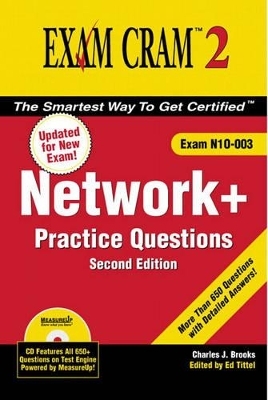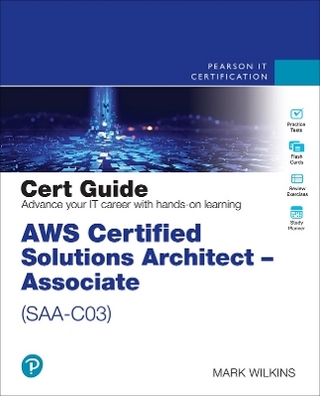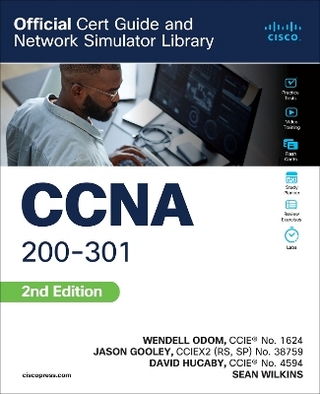
Network+ Certification Practice Questions Exam Cram 2 (Exam N10-003)
Pearson IT Certification
978-0-7897-3352-8 (ISBN)
- Titel ist leider vergriffen;
keine Neuauflage - Artikel merken
Attention Network + Candidates: Do your last minute studying with us! Network+ Exam Cram 2 Practice Questions provides you with more than 500 practice test questions for Exam N10-003. We will also provide you with complete answer explanations and the "Cram Sheet" tear card that makes this the perfect complementary study tool to your other books or classes. Make sure that you have the full understanding of the information covered in this exam with Network + Exam Cram 2 Practice Questions.
Network+ Certification Practice Questions Exam Cram 2About the Author Charles J. Brooks is currently the president of Marcraft International Corporation, located in Kennewick, Washington, and is in charge of research and development. He is the author of several books, including A+ Training Guide, A+ Concepts and Practices, and Microcomputer Systems—Theory and Service. Other titles produced by Mr. Brooks include: Speech Synthesis, Pneumatic Instrumentation, The Complete Introductory Computer Course, Radio-Controlled Car Project Manual, and IBM PC Peripheral Troubleshooting and Repair. A former electronics instructor and technical writer with the National Education Corporation, Charles has taught and written on post-secondary EET curriculum, including introductory electronics, transistor theory, linear integrated circuits, basic digital theory, industrial electronics, microprocessors, and computer peripherals. © Copyright Pearson Education. All rights reserved.
Introduction
1: Media and Topologies
Domain 1.0: Media and Topologies
Objective 1.1: Recognize Logical or Physical Topologies, Given a Schematic Diagram or Description
Objective 1.2: Specify the Main Features of the 802.2 (LLC), 802.3 (Ethernet), 802.5 (Token Ring), 802.11 (Wireless), and FDDI Networking Technologies
Objective 1.3: Specify the Characteristics (e.g., Speed, Length, Topology, Cable Type, etc.) of the Following Cable Standards: 10BASE-T, 10BASE-FL, 100BASE-TX, 100BASE-FX, 1000BASE-T, 1000BASE-CX, 1000BASE-SX, 1000BASE-LX, 10GBASE-SR, 10GBASE-LR, and 10G
Objective 1.4: Recognize the Following Media Connectors and Describe Their Uses: RJ-11, RJ-45, F-Type, ST, SC, IEEE-1394, Fiber LC, MT-RJ, and USB
Objective 1.5: Recognize the Following Media Types and Describe Their Use: Cat 3,5,5e, and 6, UTP, STP, Coax, Single-Mode Fiber, and Multimode Fiber
Objective 1.6: Identify the Purpose, Features, and Functions of the Following Network Components: Hubs, Switches, Bridges, Routers, Gateways, CSU/DSU, NICs, ISDN, WAPs, Modems, Transceivers, and Firewalls
Objective 1.7: Specify the General Characteristics (For Example: Speed, Carrier Speed, Frequency, Transmission Type and Topology) of the Following Wireless Technologies: 802.11 (Frequency Hopping Spread Spectrum), 802.11x (Direct Sequence Spread Spectrum)
Objective 1.8: Identify Factors That Affect the Range and Speed of Wireless Service (For Example: Interference, Antenna Type and Environmental Factors)
Quick Check Answer Key
Objective 1.1: Recognize Logical or Physical Topologies, Given a Schematic Diagram or Description
Objective 1.2: Specify the Main Features of the 802.2 (LLC), 802.3 (Ethernet), 802.5 (Token Ring), 802.11 (Wireless), and FDDI Networking Technologies
Objective 1.3: Specify the Characteristics (For Example, Speed, Length, Topology, Cable Type, and so on) of the Following Cable Standards: 10BASE-T, 10BASE-FL, 100BASE-TX, 100BASE-FX, 1000BASE-T, 1000BASE-CX, 1000BASE-SX, 1000BASE-LX, 10GBASE-SR, 10GBASE-
Objective 1.4: Recognize the Following Media Connectors and Describe Their Uses: RJ-11, RJ-45, F-Type, ST, SC, IEEE-1394, Fiber LC, MT-RJ, and USB
Objective 1.5: Recognize the Following Media Types and Describe Their Use: Cat 3,5,5e, and 6, UTP, STP, Coax, Single-Mode Fiber, and Multimode Fiber
Objective 1.6: Identify the Purpose, Features, and Functions of the Following Network Components: Hubs, Switches, Bridges, Routers, Gateways, CSU/DSU, NICs, ISDN, WAPs, Modems, Transceivers, and Firewalls
Objective 1.7: Specify the General Characteristics (For Example: Speed, Carrier Speed, Frequency, Transmission Type and Topology) of the Following Wireless Technologies: 802.11 (Frequency Hopping Spread Spectrum), 802.11x (Direct Sequence Spread Spectrum)
Objective 1.8: Identify Factors That Affect the Range and Speed of Wireless Service (For Example: Interference, Antenna Type, and Environmental Factors)
Answers and Explanations
Objective 1.1
Objective 1.2
Objective 1.3
Objective 1.4
Objective 1.5
Objective 1.6
Objective 1.7
Objective 1.8
2: Protocols and Standards
Domain 2.0: Protocols and Standards
Objective 2.1: Given an Example, Identify a Media Access Control (MAC) Address and its Parts
Objective 2.2: Identify the Seven Layers of the OSI Model and Their Functions
Objective 2.3: Identify the OSI Layers at Which the Following Network Devices Operate: Hubs, Switches, Bridges, Routers, NICs, and WAPs
Objective 2.4: Differentiate Between the Network Protocols in Terms of Routing, Addressing Schemes, Interoperability, and Naming Conventions for IPX/SPX, NetBEUI, AppleTalk, and TCP/IP
Objective 2.5: Identify the Components and Structure of IP Addresses (Ipv4, Ipv6) and Required Settings for Connections Across the Internet
Objective 2.6: Identify Classful IP Address Ranges and Their Default Subnet Masks
Objective 2.7: Identify the Purpose of Subnetting
Objective 2.8: Identify the Differences Between Public vs. Private Network Addressing Schemes
Objective 2.9: Identify and Differentiate Between the Following IP Addressing Methods: Static, Dynamic, and Self-Assigned (APIPA)
Objective 2.10: Define the Purpose, Function, and Use of the Following Protocols Within the TCP/IP Suite: TCP, UDP, FTP, SFTP, TFTP, SMTP, HTTP, HTTPS, POP3/IMAP4, Telnet, SSH, ICMP, ARP, NTP, NNTP, SCP, LDAP, IGMP, and LPR
Objectives 2.11 and 2.12: Define the Function of TCP/UDP Ports and Identify Well-Known Ports Associated with the Following Commonly Used Services and Protocols: FTP, SSH, Telnet, SMTP, DNS, TFTP, HTTP, POP3, NNTP, NTP, IMPA4, and HTTPS
Objective 2.13: Identify the Purpose of the Following Network Services and Protocols: DHCP/BOOTP, DNS, NAT/ICS, WINS, SNMP, NFS, Zeroconfig, SMB, AFP, LDP, and Samba
Objective 2.14: Identify the Basic Characteristics (For Example, Speed, Capacity, Media) of the Following WAN Technologies: Packet Switching, Circuit Switching, ISDN, FDDI, T1/E1/J1, T3/E3/J3, OC-x, and X.25
Objective 2.15: Identify the Basic Characteristics of the Following Internet Access Technologies: xDSL, Broadband Cable, POTS/PSTN, Satellite, and Wireless
Objective 2.16: Define the Function of the Following Remote Access Protocols and Services: RAS, PPP, SLIP, PPPoE, PPTP, VPN and RDP
Objective 2.17: Identify the Following Security Protocols and Describe Their Purpose and Function: IPsec, L2TP, SSL, WEP, WPA, and 802.1x
Objective 2.18: Identify Authentication Protocols (For Example: CHAP, MS-CHAP, PAP, RADIUS, Kerberos, and EAP)
Objective 2.1: Given an Example, Identify a Media Access Control (MAC) Address
Objective 2.2: Identify the Seven Layers of the OSI Model and Their Functions
Objective 2.3: Identify the OSI Layers at Which the Following Network Devices Operate: Hubs, Switches, Bridges, Routers, NICs, and WAPs
Objective 2.4: Differentiate Between the Network Protocols in Terms of Routing, Addressing Schemes, Interoperability, and Naming Conventions for IPX/SPX, NetBEUI, AppleTalk, and TCP/IP
Objective 2.5: Identify the Components and Structure of IP Addresses (Ipv4, Ipv6) and Required Settings for Connections Across the Internet
Objective 2.6: Identify Classful IP Address Ranges and Their Default Subnet Masks
Objective 2.7: Identify the Purpose of Subnetting
Objective 2.8: Identify the Differences Between Public Versus Private Network Addressing Schemes
Objective 2.9: Identify and Differentiate Between the Following IP Addressing Methods: Static, Dynamic, and Self-Assigned (APIPA)
Objective 2.10: Define the Purpose, Function, and Use of the Following Protocols Within the TCP/IP Suite: TCP, UDP, FTP, SFTP, TFTP, SMTP, HTTP, HTTPS, POP3/IMAP4, Telnet, SSH, ICMP, ARP, NTP, NNTP, SCP, LDAP, IGMP, and LPR
Objectives 2.11 and 2.12: Define the Function of TCP/UDP Ports and Identify Well-Known Ports Associated with the Following Commonly Used Services and Protocols: FTP, SSH, Telnet, SMTP, DNS, TFTP, HTTP, POP3, NNTP, NTP, IMPA4, and HTTPS
Objective 2.13: Identify the Purpose of the Following Network Services and Protocols: DHCP/BOOTP, DNS, NAT/ICS, WINS, SNMP, NFS, Zeroconf, SMB, AFP, LDP, and Samba
Objective 2.14: Identify the Basic Characteristics (For Example, Speed, Capacity, Media) of the Following WAN Technologies: Packet Switching, Circuit Switching, ISDN, FDDI, T1/E1/J1, T3/E3/J3, OC-x, and X.25
Objective 2.15: Identify the Basic Characteristics of the Following Internet Access Technologies: xDSL, Broadband Cable, POTS/PSTN, Satellite, and Wireless
Objective 2.16: Define the Function of the Following Remote Access Protocols and Services: RAS, PPP, SLIP, PPPoE, PPTP, VPN and RDP
Objective 2.17: Identify the Following Security Protocols and Describe Their Purpose and Function: IPsec, L2TP, SSL, WEP, WPA, and 802.1x
Objective 2.18: Identify Authentication Protocols (For Example: CHAP, MS-CHAP, PAP, RADIUS, Kerberos, and EAP)
Answers and Explanations
Objective 2.1
Objective 2.2
Objective 2.3
Objective 2.4
Objective 2.5
Objective 2.6
Objective 2.7
Objective 2.8
Objective 2.9
Objective 2.10
Objectives 2.11 and 2.12
Objective 2.13
Objective 2.14
Objective 2.15
Objective 2.16
Objective 2.17
Objective 2.18
3: Network Implementation
Domain 3.0: Network Implementation
Objective 3.1: Identify the Basic Capabilities (Client Support, Interoperability, Authentication, File and Print Services, Application Support, and Security) of the Following Server Operating Systems: UNIX/Linux, NetWare, Windows, and Appleshare IP (Internet Protocol)
Objective 3.2: Identify the Basic Capabilities Needed for Client Workstations to Connect to and Use Network Resources (For Example: Media, Network Protocols, and Peer and Server Services)
Objective 3.3: Identify the Appropriate Tool for a Given Wiring Task (Wire Crimper, Media Tester/Certifier, Punch Down Tool or Tone Generator)
Objective 3.4: Given a Remote Connectivity Scenario Comprised of a Protocol, an Authentication Scheme, and Physical Connectivity, Configure the Connection for UNIX/Linux/MAC OS X Server, NetWare, Windows, and Appleshare IP
Objective 3.5: Identify the Purpose, Benefits, and Characteristics of Using a Firewall
Objective 3.6: Identify the Purpose, Benefits, and Characteristics of Using a Proxy Server
Objective 3.7: Given a Connectivity Scenario, Predict the Impact of a Particular Security Implementation on Network Functionality (Blocking Port Numbers, Authentication, Encryption, and so on)
Objective 3.8: Identify the Main Characteristics of VLANs
Objective 3.9: Identify the Main Characteristics and Purpose of Extranets and Intranets
Objective 3.10: Identify the Purpose, Benefits, and Characteristics of Using Antivirus Software
Objective 3.11: Identify the Purpose and Characteristics of Fault Tolerance
Objective 3.12: Identify the Purpose and Characteristics of Disaster Recovery
Objective 3.1: Identify the Basic Capabilities (Client Support, Interoperability, Authentication, File and Print Services, Application Support, and Security) of the Following Server Operating Systems: UNIX/Linux, NetWare, Windows, and Appleshare IP (Internet Protocol)
Objective 3.2: Identify the Basic Capabilities Needed for Client Workstations to Connect to and Use Network Resources (For Example: Media, Network Protocols and Peer and Server Services)
Objective 3.3: Identify the Appropriate Tool for a Given Wiring Task (Wire Crimper, Media Tester/Certifier, Punch Down Tool or Tone Generator)
Objective 3.4: Given a Remote Connectivity Scenario Comprised of a Protocol, an Authentication Scheme, and Physical Connectivity, Configure the Connection for UNIX/Linux/MAC OS X Server, NetWare, Windows, and Appleshare IP
Objective 3.5: Identify the Purpose, Benefits, and Characteristics of Using a Firewall
Objective 3.6: Identify the Purpose, Benefits, and Characteristics of Using a Proxy Server
Objective 3.7: Given a Scenario, Predict the Impact of a Particular Security Implementation on Network Functionality (Blocking Port Numbers, Encryption, and so on)
Objective 3.8: Identify the Main Characteristics of VLANs
Objective 3.9: Identify the Main Characteristics and Purpose of Extranets and Intranets
Objective 3.10: Identify the Purpose, Benefits, and Characteristics of Using Antivirus Software
Objective 3.11: Identify the Purpose and Characteristics of Fault Tolerance
Objective 3.12: Identify the Purpose and Characteristics of Disaster Recovery
Answers and Explanations
Objective 3.1
Objective 3.2
Objective 3.3
Objective 3.4
Objective 3.5
Objective 3.6
Objective 3.7
Objective 3.8
Objective 3.9
Objective 3.10
Objective 3.11
Objective 3.12
4: Network Support
Practice Questions
Objective 4.1: Given a Troubleshooting Scenario, Select the Appropriate Network Utility
Objective 4.2: Given Output from a Diagnostic Utility (Tracert, Ping, Ipconfig, and so on), Identify the Utility and Interpret the Output
Objective 4.3: Given a Network Scenario, Interpret Visual Indicators (Link Lights, Collision Lights, and so on) to Determine the Nature of the Stated Problem
Objective 4.4: Given a Troubleshooting Scenario Involving a Client Accessing Remote Network, Identify the Cause of the Problem (File Services, Print Services, Authentication Failure, Protocol Configuration, Physical Connectivity and SOHO Router)
Objective 4.5: Given a Troubleshooting Scenario Between a Client and the Following Server Environments (UNIX/Linux/MAC OS X, NetWare, Windows, and Appleshare IP), Identify the Cause
Objective 4.6: Given a Scenario, Determine the Impact of Modifying, Adding, or Removing Network Services (DHCP, DNS, WINS, and so on) on Network Resources and Users
Objective 4.7: Given a Troubleshooting Scenario Involving a Network with a Particular Physical Topology (Bus, Star, Mesh, or Ring) and Including a Network Diagram, Identify the Network Area Affected and the Cause of the Stated Failure
Objective 4.8: Given a Network Troubleshooting Scenario Involving an Infrastructure Problem (Wired or Wireless), Identify the Cause of the Problem (Bad Media, Interference, Network Hardware or Environment)
Objective 4.9: Given a Network Problem Scenario, Select an Appropriate Course of Action Based on a General Logical Troubleshooting Strategy
Objective 4.1: Given a Troubleshooting Scenario, Select the Appropriate Network Utility
Objective 4.2: Given Output from a Diagnostic Utility (tracert, ping, ipconfig, and so on), Identify the Utility and Interpret the Output
Objective 4.3: Given a Network Scenario, Interpret Visual Indicators (Link Lights, Collision Lights) to Determine the Nature of the Stated Problem
Objective 4.4: Given a Troubleshooting Scenario Involving a Client Accessing Remote Network Services, Identify the Cause of the Problem (File Services, Print Services, Authentication Failure, Protocol Configuration, Physical Connectivity and SOHO Router)
Objective 4.5: Given a Troubleshooting Scenario Between a Client and the Following Server Environments (UNIX/Linux/MAC OS X, NetWare, Windows, and Appleshare IP), Identify the Cause
Objective 4.6: Given a Scenario, Determine the Impact of Modifying, Adding, or Removing Network Services (DHCP, DNS, WINS, and so on)
Objective 4.7: Given a Troubleshooting Scenario Involving a Network with a Particular Physical Topology (Bus, Star, Mesh, or Ring) and Including a Network Diagram, Identify the Network Area Affected and the Cause of the Stated Failure
Objective 4.8: Given a Network Troubleshooting Scenario Involving an Infrastructure Problem (Wired or Wireless), Identify the Cause of the Problem (Bad Media, Interference, Network Hardware or Environment)
Objective 4.9: Given a Network Problem Scenario, Select an Appropriate Course of Action Based on a General Logical Troubleshooting Strategy
Answers and Explanations
Objective 4.1
Objective 4.2
Objective 4.3
Objective 4.4
Objective 4.5
Objective 4.6
Objective 4.7
Objective 4.8
Objective 4.9
Appendix A: CD Contents and Installation Instructions
Multiple Test Modes
Study Mode
Certification Mode
Custom Mode
Missed Question Mode
Non-Duplicate Mode
Random Questions and Order of Answers
Detailed Explanations of Correct and Incorrect Answers
Attention to Exam Objectives
Installing the CD
Creating a Shortcut to the MeasureUp Practice Tests
Technical Support
| Erscheint lt. Verlag | 23.6.2005 |
|---|---|
| Verlagsort | Upper Saddle River |
| Sprache | englisch |
| Maße | 229 x 154 mm |
| Gewicht | 398 g |
| Themenwelt | Mathematik / Informatik ► Informatik ► Netzwerke |
| Informatik ► Weitere Themen ► Zertifizierung | |
| ISBN-10 | 0-7897-3352-8 / 0789733528 |
| ISBN-13 | 978-0-7897-3352-8 / 9780789733528 |
| Zustand | Neuware |
| Haben Sie eine Frage zum Produkt? |
aus dem Bereich


